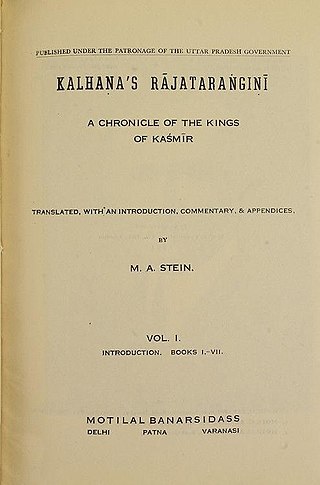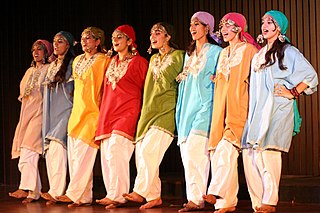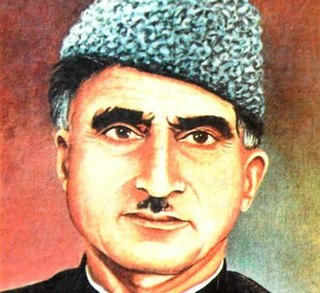Related Research Articles

The history of Kashmir is intertwined with the history of the broader Indian subcontinent in South Asia with influences from the surrounding regions of Central, and East Asia. Historically, Kashmir referred to only the Kashmir Valley of the western Himalayas. Today, it denotes a larger area that includes the Indian-administered union territories of Jammu and Kashmir and Ladakh, the Pakistan-administered territories of Azad Kashmir and Gilgit-Baltistan, and the Chinese-administered regions of Aksai Chin and the Trans-Karakoram Tract.

The Kashmiri Pandits are a group of Kashmiri Hindus and a part of the larger Saraswat Brahmin community of India. They belong to the Pancha Gauda Brahmin group from the Kashmir Valley, located within the Indian union territory of Jammu and Kashmir. Kashmiri Pandits are Hindu Kashmiris native to the Kashmir Valley, and the only remaining Hindu Kashmiris after the large-scale of conversion of the Valley's population to Islam during the medieval times. Prompted by the growth of Islamic militancy in the valley, large numbers left in the exodus of the 1990s. Even so, small numbers remain.

Rājataraṅgiṇī is a metrical legendary and historical chronicle of the north-western part of India, particularly the kings of Kashmir. It was written in Sanskrit by Kashmiri historian Kalhana in the 12th century CE.

Kashmiris are an Indo-Aryan ethnolinguistic group speaking the Kashmiri language and originating from the Kashmir Valley, which is today located in Indian-administered Jammu and Kashmir.

Ranbir Singh was Maharaja of Jammu and Kashmir from 1856 until his death in 1885.

Sharada Peeth is a ruined Hindu temple and ancient centre of learning located in the Neelum Valley of Pakistan-administered Azad Kashmir in the disputed Kashmir region. Between the 6th and 12th centuries CE, it was among the most prominent temple universities in the Indian subcontinent. Known in particular for its library, stories recount scholars travelling long distances to access its texts. It played a key role in the development and popularisation of the Sharada script in North India, causing the script to be named after it, and Kashmir to acquire the moniker "Sharada Desh", meaning "country of Sharada".
Pandit Taba Ram Turki lived at Rainawari, Srinagar and wrote Persian poetry under the pen name (takhalus) of Betab. Betab made an important contribution to the Persian poetry and he commanded great respect among the poets of Kashmir of his time. Betab was an exceptional poet whose Persian poetry reached as far as Central Asia. Some critics have rated Betab's works at par with the Shahnama of Firdausi. Betab was also proficient with reading and writing Arabic.
Sapru, also spelled as Sipru or Saproo is a Kashmiri Pandit clan and surname native to the Kashmir Valley of Jammu and Kashmir, India.
Islam is the majority religion practised in Kashmir, with 97.16% of the region's population identifying as Muslims as of 2014. The religion came to the region with the arrival of Mir sayed Ali shah Hamdani, a Muslim Sufi preacher from Central Asia and Persia, beginning in the early 14th century. The majority of Kashmiri Muslims are Sunni Muslims, and Shias account for between 20% and 25% of the Muslim population, who mostly reside in north and central Kashmir. They refer to themselves as "Koshur" in their mother language. Non-Kashmiri Muslims in Kashmir include semi-nomadic cowherds and shepherds, belonging to the 𝙂𝙪𝙟𝙟𝙖𝙧𝙨 and Bakarwal communities.
The Lohara dynasty was a Kashmiri Hindu dynasty that ruled over Kashmir and surrounding regions in the northwestern part of the Indian subcontinent, for more than 3 centuries between 1003 CE and approximately 1320 CE. The early history of the dynasty was described in the Rajatarangini, a work written by Kalhana in the mid-12th century and upon which many and perhaps all studies of the first 150 years of the dynasty depend. Subsequent accounts, which provide information up to and beyond the end of the dynasty come from Jonarāja and Śrīvara. The later rulers of the dynasty were weak: internecine fighting and corruption were endemic during this period, with only brief years of respite, making the dynasty vulnerable to the growth of Islamic conquests in the region.
A damara was a feudal landlord of ancient Kashmir.
Jalali is a Kashmiri surname. Notable people with the surname include:

Pheran or Phiran is the traditional outfit for both males and females in Kashmir.

Avantivarman founded the Utpala dynasty. He ruled Kashmir from 855 to 883 CE and built the Avantiswami Temple in Awantipora, Pulwama.
Pandit is an Indian and Nepalese Brahmin surname. When prefixed to a name, it denotes a scholar, for example, Pandita Ramabai or Pandit Nehru. A Hindu priest is also respectfully called Pandit ji.
Uchchala or Uchchala Deva, was a King of Kashmir who ruled for 10 years from 1101 to 1111 AD. He belonged to Utpala dynasty, a Hindu Kingdom of Kashmiri rulers and was the founder of "Second Lohara dynasty". He was the close relative of Harsha and the brother of "Sussala".

Ghulam Mohiuddin Hajni was a Kashmiri writer, critic, political activist and teacher. He wrote in regional and foreign languages such as Urdu, Persian, Arabic and primarily in Kashmiri language. In 1970, he became the recipient of Sahitya Akademi Award for his research publication titled Maqalati Hajini.
Fotedar or Fotadar is a Kashmiri clan, kram and surname native to the Kashmir Valley of Jammu and Kashmir, India.
References
- ↑ Jafri, Saiyid Zaheer Husain (February 10, 2012). Recording the Progress of Indian History: Symposia Papers of the Indian History Congress, 1992-2010. Primus Books. ISBN 9789380607283 – via Google Books.
- ↑ Allie, Dr M. Yaqoob; Dar, Nisar Ahmad (August 5, 2019). Economy of Early Kashmir. Book Bazooka. ISBN 9789386895639 – via Google Books.
- ↑ Raina, Mohini Qasba (November 13, 2014). Kashur The Kashmiri Speaking People. Partridge Publishing Singapore. ISBN 9781482899450 – via Google Books.
- ↑ Singh, Ajay Kumar (February 10, 1985). "Trans-Himalayan Wall Paintings: 10th to 13th Century A.D." Agam Kala Prakashan – via Google Books.
- ↑ Hutchison, Rose (1996). Gazetteer of the Chamba State. Indus Publishing. p. 79. ISBN 978-81-7387-041-5.
- ↑ Mohan, Krishna (1958). Kashmir under the Loharas, A.D. 1003–1171 (PhD diss.). SOAS University of London. p. 38. doi:10.25501/SOAS.00029638.
- 1 2 "Kashmir's Fairer Lords". January 19, 2016.
- ↑ "Social political economic and legal position status and role of women in society of early medival[sic?] period in north India 700 A.D. to 1200 A.D." (PDF). INFLIBNET Centre. 27 September 2012. Retrieved 29 October 2020.
- ↑ Raina, Mohini Qasba (November 13, 2014). Kashur The Kashmiri Speaking People. Partridge Publishing Singapore. ISBN 9781482899450 – via Google Books.
- 1 2 Bamzai, P. N. K. (February 10, 1994). Culture and Political History of Kashmir. New Delhi: M.D. Publications Pvt. Ltd. p. 155. ISBN 8185880328.
- ↑ Kumar, Raj (February 10, 2008). History Of The Chamar Dynasty : (From 6Th Century A.D. To 12Th Century A.D.). Gyan Publishing House. ISBN 9788178356358 – via Google Books.
- ↑ Bingley, A. H.; Cunningham, W. B.; Longden, A. B.; Charak, Sukh Dev Singh (February 10, 1979). "Introduction to the history and culture of the Dogras". Ajaya – via Google Books.
- 1 2 Sharma, Mahesh (2009). Western Himalayan Temple Records: State, Pilgrimage, Ritual and Legality in Chambā. Leiden: BRILL. p. 33. ISBN 9789004176935.
- 1 2 Tikoo, Colonel Tej K. Kashmir: Its Aborigines and Their Exodus. Lancer Publishers LLC. ISBN 9781935501589 – via Google Books.
- ↑ Schofield, Victoria (December 31, 1996). Kashmir in Conflict: India, Pakistan and the Unending War. Bloomsbury Academic. ISBN 9781860640360 – via Google Books.
- ↑ Singh, Mian Goverdhan (1999). Wooden Temples of Himachal Pradesh. New Delhi: Indus Publishing. p. 122. ISBN 81-7387-094-2.
- ↑ Bamzai, P. N. K. (1994). Culture and Political History of Kashmir, Volume 1. New Delhi: M.D. Publications Pvt. Ltd. pp. 154–155. ISBN 81-85880-32-8.
- ↑ Ahmad, Dr Bashir (February 10, 2003). "Jammu and Kashmir State: Kashmir region". State Gazetteers Unit, Government of Jammu and Kashmir – via Google Books.